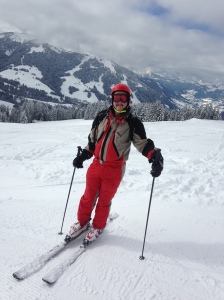Chris Harper on considering stem cell transplant
 Transplant, to do or not to do. As a 57 year old who was Intermediate Risk 2 (IR2), once I was told the prognosis and that, with an enlarged spleen, activities I loved like skiing and kayaking were now dangerous to me, it was a no-brainer. I didn’t like what was going on inside me and wanted it resolved as soon as possible.
Transplant, to do or not to do. As a 57 year old who was Intermediate Risk 2 (IR2), once I was told the prognosis and that, with an enlarged spleen, activities I loved like skiing and kayaking were now dangerous to me, it was a no-brainer. I didn’t like what was going on inside me and wanted it resolved as soon as possible.
Myelofibrosis arrived out of the blue as I had an excellent health record and was quite fit. It was a shock for me and my family. I moved from the initial despair of a terminal prognosis to hope via the possibility of a stem cell transplant (SCT)through the learning and consulting process. Was I too old, would I get a match, would I survive the process, lots of questions to answer. I was confident in my disease specialist, Dr Claire Harrison, who recommended SCT. I remember her words: ‘If you were my father, or husband, that is what I would recommend’.
I was quickly passed on to an excellent transplant team at University College Hospital London that continued my education as I learned about the process, risks, survival odds etc. The survival odds were reasonable, and doing nothing had a definitive outcome that I wished to avoid, and so we moved forward. Next were tests to ensure that my body could handle it, as not all are suitable for transplant, and a search for a donor match. My siblings were both upset that they did not match but a Matched Unrelated Donor (MUD) was found.
In preparing my body for transplant the week of chemo was fairly straightforward but then came conditioning which made me feel very ill for 3-4 days, but, this was just as the medics had ‘promised’. This short period is not pleasant and affects different people in different ways, but it is manageable albeit exhausting. Then my small bag of new life arrived, given just like a transfusion. Now began the nervous wait for my blood counts to rise and indicate that the cells were engrafting as my donor took over. Several days of anticipation and then the numbers change and grow like a blooming flower opening in a desert.
Released from hospital soon after, there followed a pretty exhausting roller coaster period for many weeks while my body and cells got acquainted. Some days raring to go and others just too tired to do anything. Bi-weekly hospital visits for checks, more if I needed to be transfused, which I did for the first 8 weeks. Niggles and pains that made me wonder if all was well or perhaps I was experiencing GVHD(graft versus host disease). Gradually I settled into the new normal me, vigilant but confident.
Six months later I felt pretty much back to normal, if I ever was, although still on medication and cautious of infection risk. What was my normal once I had had my childhood inoculations again. I am now kayaking skiing and distance running. I am still wary of disease/infection and steer clear of anyone unwell as I take longer to recover from colds etc. as my immune system rebuilds, but that is not a problem.
I met my donor, Sarah, after two years and was delighted to meet this lovely mum of four who had given her time to help save my life.
I go to MPDVoice patient meetings to help others who might have to tread the same path. At one meeting I had a myelofibrosis badge on to ID my source disease for fellow patients. At the end of the evening Claire Harrison pulled the label off my jumper saying ‘You don’t have that any more’.
I buddy patients I meet via MPDVoice or on the internet. I share my experience and give the patients perspective;  I will talk to anyone I can help. In many cases this continues throughout the treatment as we compare notes! I have made many new friends all over the world as we all help each other.
I will talk to anyone I can help. In many cases this continues throughout the treatment as we compare notes! I have made many new friends all over the world as we all help each other.
It is not an easy path to walk but easier if you walk it hand in hand with a loved one, in my case my wife Lesley who slept in my room most nights during my treatment.
It is scary, it is tough but it is worth it. Once on your way, be bold and positive. The prize is life!


Leave a comment